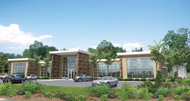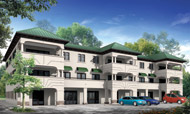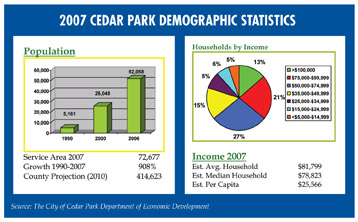| COVER STORY, APRIL 2008
THE RULES OF ATTRACTION...AND RETENTION
Economic development authorities in the cities of The Colony, Friendswood, Sugar Land and Cedar Park are helping to recruit new companies and retain current business.
Lindsey Walker
When a major corporation decides to relocate its headquarters or a local company expands into more space in the same city, it most likely didn’t happen by chance. The hardworking members of the local economic development organizations are behind the scenes, constantly working to figure out how to generate more business in their communities while also focusing on the existing business in their area. This month in Texas Real Estate Business, we feature four economic development corporations that have made a difference in their cities.
City of The Colony
With Lake Lewisville as its backyard, the city of The Colony, Texas, has an advantage for recruiting businesses that some other cities don’t. In addition to this draw, The Colony also benefits from a location only 20 miles north of downtown Dallas, a pro-business government and a high quality of life. In order to capitalize on these features, the city created The Colony Economic Development Corporation in 1997. The following year, city voters approved the 4A and 4B sales taxes to generate revenue to offer incentives to businesses, to market the city and to fund quality of life programs.
“We have programs in place to help [meet our goals], such as a strategic plan, a marketing plan, a list of incentives that can be offered to specific types of businesses and a great relationship with The Colony city council to get incentives approved from the economic development corporation as well as the city itself,” says Tom Terrall, director of economic development for The Colony Economic Development Corporation. “These programs were put into place beginning in 1998 when the 4A sales tax was passed by The Colony voters and has grown since that time.”
With zoning for retail, office and light industrial uses, the city is focused on attracting those three types of businesses.
“If we had an area zoned for heavy industrial, we would also be interested in those companies,” Terrall adds. “But, our city is only about 15 square miles and we have no place for the heavy industrial businesses, though we do have a couple of parcels that can accommodate the distribution/warehouse/light assembly type of business.”
The majority of current and planned development is taking place in three main areas of the city — along the State Highway 121 corridor running through The Colony, on Wynnwood Peninsula west of FM 423, and in the southern most portion of the City in Austin Ranch, according to Terrall. In the past year, the corporation has been able to attract some retail businesses to open along S.H. 121, including Ross Dress For Less, Staples and Texas Roadhouse restaurant, and several larger developments are underway in the same area. Austin Ranch, for example, is a multifamily-focused, mixed-use project located just south of S.H. 121. Thus far, the development features about 2,000 apartment units, some townhomes, some retail and restaurants.
“Phase V has just begun. It will consist of around 535 more multifamily units; 9,000 square feet of restaurant uses; 13,631 square feet of retail; a four-story parking garage; and a park,” Terrall says. “The company recently signed an agreement with the city to put additional infrastructure in place in Austin Ranch in order to develop commercial parcels with corporate campus-style offices, and plans also call for more retail development at the intersection of Plano and Windhaven parkways.”
Peter Calthorpe master-planned Austin Ranch’s residential community, and Lucy Billingsley of the Billingsley Company are developing and managing the project.
Another development is a 50-acre retail project on S.H. 121 east of Blair Oaks that should be under construction by the second quarter. Also, Cascades at The Colony — a mixed-use development located on S.H. 121 and Morning Star with its 200,000-square-foot Phase I nearly complete — is scheduled to begin construction on its second phase in May. The first phase comprises flex/office buildings built for small and mid-size distribution, light assembly or storage tenants; Phase II will feature a Residence Inn by Marriott and a Fairfield Inn & Suites with approximately 100 rooms each. The project was master-planned by BOKA Powell and is being developed by Jackson Shaw.
“Future phases encompass approximately 200,000 square feet of office space and approximately 100,000 square feet of retail,” Terrall adds. Jackson-Shaw is currently looking for some pad site users, such as restaurants, to compliment and service the hotels.
“Employment at this location will help boost The Colony’s daytime population, which will attract more restaurants and other retail businesses,” Terrall says.
With a total population of around 39,300, the city of The Colony has a residential base that consists of a highly trained workforce (approximately 30.72 percent of the workforce has a minimum of an undergraduate degree) and an unemployment rate of 3.8 percent.
“Due to the influx of new companies and the expansion of existing companies in the North Texas area, I believe the job market is excellent,” Terrall says. “Our future economic outlook is bright; we are located at the center of business and population growth. Having more business locate in The Colony will help to diversify the tax base. This will also bring more local sales tax to our city so we can continue to offer a high level of service to our residents. That is the goal of The Colony Economic Development Corporation.”
City of Friendswood
 |
The city of Friendswood, Texas, has been able to attract commercial users such as the city’s first green office building. Jacob White Construction Company is building the nearly $2 million, single-story project, which will feature a grass roof and water catchment system. The company will relocate its headquarters to occupy 5,000 of the building’s 10,000 square feet.
|
|
The economic development office for the city of Friendswood, Texas — located halfway between Houston and Galveston — was created in July 1999 to pursue a diversified tax base in the city, which is mostly residential. Now having been established for almost a decade, the goal of the office still lies in the idea of diversification, working to achieve a tax base consisting of 80 percent residential and 20 percent commercial. In fact, the city’s Comprehensive Plan is being updated to facilitate this goal.
In order to attract more commercial users, the city, which currently boasts an unemployment rate of 3.4 percent, offers several incentive programs for businesses, including tax abatement, tax increment financing and a municipal grant program.
“The municipal grant program allows businesses to expand or relocate in the city and utilize the municipal grant funds to help offset their costs for infrastructure, road improvements, drainage, land or building acquisition, building improvements or renovation, or city-related permit or impact fees,” says Karen Capps, economic development coordinator for the city of Friendswood.
The city is targeting certain businesses with its efforts. On the wish list are professional office development, medical facilities (minor care/outpatient), aerospace, hotels and more retail that caters to an affluent residential base.
 |
Crystal Creek Developers, the developers of a new Friendswood project, the Design Center, received an economic incentive grant that will reimburse up to $30,000 for fees paid to the city relating to the construction and development of the 21,600-square-foot office/retail project.
|
|
The city, which has a population of 36,000, also would like to attract more mixed-use developments that are primarily commercial as well as business parks that include wholesale, service-related business and manufacturing. Over 3,000 engineers currently call Friendswood home.
One development in Friendswood that should help stimulate these types of commercial businesses is West Ranch, a 766-acre master-planned development by Friendswood Development Company. The community, which is bordered by Centennial Park, Chigger Creek and Clear Creek, will feature 1,500 homes, more than 60 acres of park space, 100 acres of nature trails tying into Centennial Park, two recreation complexes, a resort-style swimming pool, a competition-size pool, a fish landing and a community clubhouse. In addition, 68 acres of commercial space will include a 23-acre Village Center that is projected for 2010.
As one of Money Magazine’s 2007 Best Places to Live, the city of Friendswood has plenty to offer new businesses and their employees.
“Friendswood has a highly educated workforce with more than 52 percent of residents having achieved a Bachelor’s or Master’s degree,” Capps says. “Due to its highly educated resident base, the city’s household income is more than $114,000 with the lowest crime rate in the region.”
City of Sugar Land
 |
Coca-Cola North America recently selected to relocate its Minute Maid Business Unit headquarters to Sugar Land Town Square (above) in Sugar Land, Texas.
|
|
Also a few miles outside of Houston lies Sugar Land, Texas. The city of 77,982 was one of the fastest growing cities in the country during the 1990s, which led to the development of the economic development department in June 1999 by the Sugar Land City Council.
“The city determined that a dedicated economic development would enhance their business recruitment and retention efforts and provide a positive influence on attaining their goals and objectives for a strong local economy” says Regina Morales, director of economic development for the city of Sugar Land.
Focusing on projects within the Sugar Land city limits, the department strives to diversify the city’s economy in order to ensure sustainability during economic changes, to attract development as a regional employment center, to create a balanced tax base, and to raise adequate funding for economic development activities. The economic development department has many programs in place to support these goals, such as marketing; recruitment; business retention and expansion; the Shop Sugar Land Program, which markets the city’s 900 retail, restaurant and entertainment venues; and the Heritage Program, with which the city has actively acquired and preserved the artifacts from the Imperial Sugar refinery that has been at its site since 1846.
Based on a Target Industry analysis, the city currently focuses on attracting corporate headquarters; software development; biotechnology research and application; pharmaceutical development and manufacturing; medical technology research and application; and energy and engineering. With Sugar Land’s highly educated workforce, low taxes, master-planned communities and aggressive economic development incentives, the city has been able to generate a substantial amount of new business in the past year.
“In 2007, Sugar Land’s economic development efforts encouraged more than $141 million in new investment, 1,240 jobs and 1.4 million square feet of new facilities,” Morales says.
According to Morales, during the past year, Minute Maid, Bechtel Equipment Operations and Finger Furniture have completed or announced headquarter relocations to Sugar Land. Additional success stories include the completion of the 157,000-square-foot, Class A Three Sugar Creek office building, the expansion of Fluor Corporation, Tramontina USA and National Oilwell as well as the opening of Whole Foods.
Currently under development right now in Sugar Land are Lake Pointe Town Center and Telfair. Lake Pointe is a 190-acre, mixed-use project featuring upscale residential; urban retail and restaurants; both medical and traditional office space; and medical facilities. The pedestrian-friendly project, which sits at the crossroads of Highway 6 and U.S. 59 directly across from Sugar Land Town Center, is being developed by locally based Planned Community Developers.
Newland Communities’ Telfair — a 2,000-acre, master-planned community located just off U.S. 59 and University Boulevard — offers both residential and commercial opportunities.
“One of the most visible amenities at Telfair is its central 70-acre lake and park system, which meanders through the community,” Morales says. “Marked by a dramatic pair of arched suspension bridges, this linear park offers places to jog, walk and bike.”
In planning stages is the Imperial Sugar redevelopment by Cherokee Investments and Southern Land Company. The venture is redeveloping the historical site and adjacent land into a master-planned, mixed-use development with extensive park space, a Sugar Land Heritage Museum and unique residential, retail and office offerings. (See “Sugar Land Set for Sweet Success” on page 30.)
“These new developments continue to provide well-planned mixed-use environments expanding the residential, commercial and office opportunities which strengthens the city’s goal as a location to live, work, play and shop,” Morales says.
As evidenced by these projects, large-scale developments are planned and in progress throughout the city — the highest concentration existing between Highway 90A and U.S. 59, according to Morales. More projects should be on the horizon as the job market in Sugar Land continues to strengthen.
“There has been a 95 percent increase in jobs since 1999, totaling more than 40,000, and a 3.38 percent unemployment rate for 2007,” Morales says.
Sugar Land’s strengths have always been found in the insightful and forward thinking vision of leadership and the implementation of those visions and goals since the early 1900s, according to Morales. “This quality of life, exceptional amenities and business opportunities has earned the city many accolades such as One of America’s Best Places to Live and Best Place to Raise a Family in 2006,” she says. “Sugar Land continues to strategically position itself as the preferred destination for both raising a family, business relocation and employment as well as shopping and entertainment.”
City of Cedar Park
Austin’s far northwest suburb of Cedar Park, Texas, hasn’t had an economic development department for as long as Friendswood and Sugar Land, but the city is making up for lost time.
Established by a vote of the city council in April 2005, the city of Cedar Park’s economic development department covers the city limits as well as the city’s extra-territorial jurisdiction (ETJ). The city offers a number of flexible, performance-based incentive programs that are designed to assist qualified companies that are relocating to the city as well as to assist local companies in their expansions, according Phil Brewer, director of economic development for the city of Cedar Park.
“The city’s goals are to diversify and expand the tax base as well as create and retain employment opportunities in Cedar Park,” he adds. “Because of the city’s location next to Austin, we have focused our efforts on targeting electronics, software, biotechnology and other technology-based companies.”
With these efforts, the city, which has a population of more than 53,000 within the city limits and another 25,000 in the ETJ, has been able to attract several new businesses. BMC West, for example, currently is building a new 120,000-square-foot materials distribution facility on BMC Drive, and 3PS, Inc., moved into a new 20,000-square-foot manufacturing facility in LaJaita Business Park last November. In terms of expansion, ETS-Lindgren is completing a 50,000-square-foot expansion to their existing facility in LaJaita Business Park. It should be ready for occupancy this spring.
A couple of major developments in the city of Cedar Park should contribute to future economic growth in the area. An approximately 900,000-square-foot power center being developed by Endeavor Real Estate Group called 1890 Ranch will be Cedar Park’s largest shopping center to date. Currently under construction on the project’s second phase, major national tenants Target, Cinemark, OfficeMax, Circuit City, PetsMart, Starbucks Coffee, FedEx/Kinko’s and Wachovia Bank opened this fall, and many others (Academy Sports and Gold’s Gym) are on track to open this summer. The project is located at the northeast quadrant of Highway 183A and FM 1431. Other significant developments include the 150-bed Cedar Park Regional Medical Center, which opened on Medical Parkway in December; Cedar Park Event Center, a 6,800-seat multi-purpose facility to be home to the Dallas Stars AHL affiliate (Texas Stars) once it opens at the northwest corner of Highway 183A and New Hope Road in August 2009; and a major 300-room resort hotel that is in the works and should be under construction on FM 1431 east of Parmer Lane this summer.
“While the development is spread around the city, the majority of current and planned development is focused in the area along the new 183A toll road or in the FM 1431 corridor east of the toll road to Interstate Highway 35,” says Brewer.
Cedar Park’s proximity to Austin is one of its selling points to potential new businesses, but it’s not the only one. Cedar Park has a supportive city government, outstanding quality of life and excellent schools, combining to make the city an ideal location for companies considering expanding or relocating their operations to the greater Austin area, according to Brewer. Backing up his statements, Family Circle recently rated Cedar Park as one of the top 10 cities in the United States to raise a family, and Forbes Magazine rated the city as the 11th fastest growing suburban city in America from 2000 to 2006.
The majority of jobs being created that aided in these accolades are concentrated in the medical/health care and service industries. With an unemployment rate of 3.5 percent, the city of Cedar Park should see continued strength in the future.
Says Brewer, “The job market in the greater Austin area is strong as companies continue to expand and add employees to their operations.”

©2008 France Publications, Inc. Duplication
or reproduction of this article not permitted without authorization
from France Publications, Inc. For information on reprints of
this article contact Barbara
Sherer at (630) 554-6054.
|
